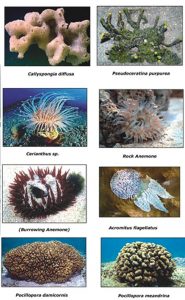Marine and Coastal Biodiversity
The oceans cover 71% of the planet’s surface area, and 95% of the biosphere. They produce a third of the oxygen that we breathe, offer a valuable source of proteins , and are among the largest natural resources of Carbon dioxide and moderates global climatic change. Some species, such as the great auk and the sea mink, are extinct; others, notably the great whales, have been hunted to fractions of their original populations. Species diversity is known to be as high as 1000 per square metre in the Indo-Pacific Ocean, and new oceanic species are continuously being discovered, particularly in the deep sea. Tropical marine ecosystems of Kerala coasts includes lagoons, mangrove swamps, sandy and rocky shores and open sea front. Apart from fishes Kerala coast has a rich array of Crustaceans, corals, echinoderms, mollusks, turtles etc.
Marine Biodiversity of Kerala
| Sl No | Group | Approx number of species |
| 1 | Phytoplankton | 468 |
| 2 | Sea weeds | 118 |
| 3 | Mangroves | 33 |
| 4 | Zooplankton | 251 |
| 5 | Sponges | 91 |
| 6 | Coelentrates | 151 |
| 7 | Annelida | 154 |
| 8 | Crustacea | 218 |
| 9 | Echinodermata | 112 |
| 10 | Gorgonids | 34 |
| 11 | Mollusca | 730 |
(Joshi et al, 2015)
Marine vertebrates – India & Kerala
| Marine |
| Taxonomic group | India | Kerala** | Percent in Kerala |
| Fishes | 2546 | 716 (28.1%) | 28.1 |
| Reptiles | 35 | 9 (25.7%) | 25.7 |
| Mammals | 25 | 23 (92 %) | 92.0 |
(Nameer et al , 2015)

Major threats to marine and coastal ecosystems include:
• Land-based pollution
• Overfishing, destructive fishing, and illegal, unreported and unregulated fishing
• Invasions of exotic species
• Global climate change